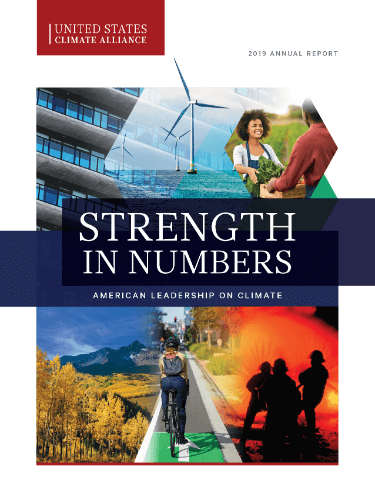Home / U.S. Climate Alliance States Within Reach of their Commitment to the Paris Agreement

COP25 in Madrid, Spain – The United States Climate Alliance, a bipartisan coalition of 25 governors committed to achieving the goals of the Paris Agreement, today released its 2019 Annual Report titled “Strength in Numbers: American Leadership on Climate” at the climate negotiations at COP25.
In the roughly two years since the Alliance was launched, the coalition has grown to twenty-five governors — both Democrats and Republicans — representing 55 percent of the U.S. population and 60 percent of U.S. GDP. Through thoughtful, coordinated state action, these governors are filling the federal leadership void, aiming to reduce their collective greenhouse gas (GHG) emissions by at least 26 to 28 percent below 2005 levels by 2025, with many adopting substantially more ambitious emission reduction targets. Generating 40 percent of U.S. GHG emissions, this coalition is equivalent to the world’s sixth largest emitter. Today the Alliance has become an entity of global importance, capable of making a genuine impact on global emissions through its leadership and action.
Alliance states are reducing their emissions and growing their economies faster than the rest of the country — demonstrating that climate leadership and economic growth go hand-in-hand. Between 2005 and 2017, Alliance member states reduced their collective GHG emissions by 16 percent, compared to 7 percent for the rest of the country — more than twice the rate. In that period, the combined per-capita economic output generated by these states and territories grew by 12 percent compared to 4 percent for the rest of the country. As a result of Alliance leadership, communities across these states have benefited from lower levels of harmful air pollutants; increased access to cheaper, cleaner energy; more efficient vehicles; and high-quality clean energy jobs.
According to independent analysis, the Alliance is on track to continue reducing GHG emissions through 2025, within reach of their GHG emissions reduction target. Considering policies currently in place, their collective GHG emissions are projected to fall by at least 20-27 percent below 2005 levels by 2025. Compared to last year, Alliance states are now collectively reducing emissions across a larger share of the U.S. economy, making a bigger dent in national emissions. They have substantially accelerated the pace and scale of climate policies adopted over the past year. It is expected this leadership will further drive down emissions beyond 2025, putting Alliance states on a path to reducing GHG emissions up to 32 percent below 2005 levels by 2030. But extensive work remains to ensure this goal becomes a reality and to preserve the opportunity for the United States to re-enter the community of nations working together to avoid catastrophic climate change.
Read more in our 2019 Annual Report here.
Launched in 2017 by the governors of Washington, New York, and California to help fill the void left by the U.S. federal government’s withdrawal from the Paris Agreement, the Alliance has grown to include 24 governors from across the U.S. representing approximately 60 percent of the U.S. economy and 55 percent of the U.S. population. Governors in the Alliance have pledged to collectively reduce net greenhouse gas emissions by at least 26-28 percent by 2025, 50-52 percent by 2030, and 61-66 percent by 2035, all below 2005 levels, and collectively achieve overall net-zero greenhouse gas emissions as soon as practicable, and no later than 2050.
The Alliance’s states and territories continue to advance innovative and impactful climate solutions to grow the economy, create jobs, and protect public health, and have a long record of action and results. In fact, the latest data shows that as of 2023, the Alliance has reduced its collective net greenhouse gas emissions by 24 percent below 2005 levels, while increasing collective GDP by 34 percent, and is on track to meet its near-term climate goal of reducing collective greenhouse gas emissions 26 percent below 2005 levels by 2025.
###